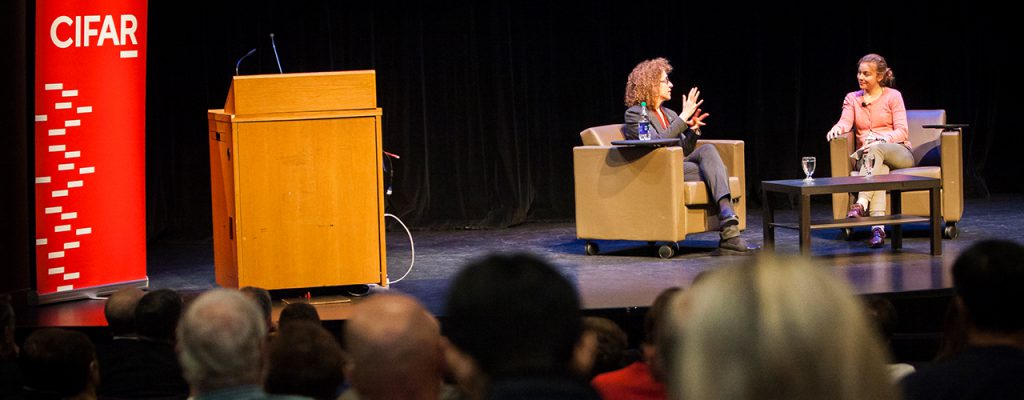By: Cynthia Macdonald
5 Nov, 2018

CIFAR Massey Talk explains what’s known – and what’s not – about radio signals from the edge of the universe.
The distinguished McGill astrophysicist Victoria Kaspi excels at solving the mysteries of the cosmos – and in the strange phenomenon known as fast radio bursts (FRBs), she’s found one of her most challenging cases yet.
In a CIFAR Massey Talk on October 11, the R. Howard Webster Foundation Fellow and director of CIFAR’s Gravity & the Extreme Universe program explained what little is known about these brilliant flashes of light. They appear to be the result of cataclysmic events that took place billions of years ago in the known universe’s farthest reaches. Lasting mere thousandths of a second, any evidence of these events can only be detected by the world’s most powerful telescopes.
“The bottom line is, we don’t know where they’re coming from,” Kaspi said. “They’re something ubiquitous in the universe, of totally unknown origin.” The lineup includes several suspects so far: collapsing or colliding stars, merging black holes, or stars with special properties such as magnetars. Since only one FRB has been seen to repeat in the same region, Kaspi theorizes that different flashes may have different origins.
At the time of Kaspi’s lecture, only 50 FRBs had been found. The first was in Australia in 2007, at the massive Parkes telescope. Kaspi was part of the team that discovered the repeater in 2012, at Puerto Rico’s Arecibo Observatory. After Arecibo, she and her fellow scientists embarked on a global road trip that took them to observatories in New Mexico and Hawaii, in an effort to pinpoint the FRB’s location.
Though astrophysicists can’t say what’s causing the FRBs (“currently, there are more theories than there are actual events,” Kaspi says) they’re nonetheless able to locate them in time and space. The flashes arrive in the form of radio waves. Not all the radio frequencies check in at the same time, however; the “dispersive sweep” or time lag of such arrivals enables scientists to calculate how far away the flashes occurred.
A special telescope known as an interferometer assists in determining where an FRB originated. The repeating Arecibo burst turned out to have come from what Kaspi called “a tiny little smudge of a galaxy,” very unlike our own expansive Milky Way.
Kaspi speculated that the large volume of press coverage generated by the FRB discoveries may result from the unfounded but tantalizing idea that the flashes might represent some form of extraterrestrial intelligence. “Aliens – where did they get that?” she asked, as the audience laughed. “I do think a lot of the press we get has to do with our using terms like ‘radio signals,’ which might suggest to some people that this is not a natural phenomenon. But that was never our intention.”
Kaspi also discussed the CHIME telescope, located near Penticton, British Columbia. Co-funded by several Canadian government partners, with additional support from NSERC and CIFAR, CHIME is poised to be nothing less than the world’s best FRB detector. Its unusual multi-cylinder design, massive size (“equivalent to about five hockey rinks,” said Kaspi) and ongoing equipment upgrades make it perfectly suited to the task. Further, surrounding mountains offer natural protection from the interference of cellphone signals.
CHIME detected its first FRB in July, but Kaspi thinks its work has only just begun. The telescope offers an extraordinarily large view of the sky – “like having a thousand Parkes telescopes at the same time” – and it may well be that soon, it will be finding multiple flashes per day. Kaspi said that the sheer volume of data she anticipates from CHIME will enable her and other astro-sleuths to identify, once and for all, the origin of these bizarre flashes.